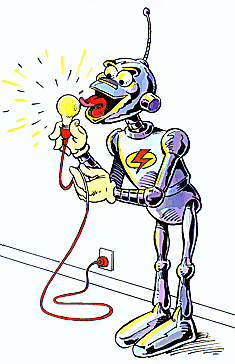photo-, phot-, -photic
(Greek: light; ultraviolet and infrared radiation; radiant energy)
These devices are made of various semiconductor materials including silicon, cadmium sulfide, cadmium telluride, and gallium arsenide, in single crystalline, polycrystalline, or amorphous forms.
When this property of light is combined with the properties of semiconductors, electrons flow in one direction across a junction, setting up a voltage.
With the addition of circuitry, current flows and electric power is available.
2. A panel assembled from a number of individual photovoltaic cells electrically interconnected in a series and parallel.
A click on the image will take you to the series of illustrated quizzes which will appear in random order or you may click on this image quiz link.
Verging on what some consider to be a "new science": photovore, photovorous.

Light-craving or photovorous robots
The words photovore, photovory, photovorous refer to feeding on or “ingesting” light as a source of energy. Especially applicable to light-seeking robots.
The robot shown above does not represent the kinds of robots built by Mark Tilden and his robot designers from high schools and up into various adult levels of inventors.
Light-craving robots are based on what is called BEAM principles (biology, electronics, aesthetics, and mechanics).
BEAM is a style of robotics that primarily uses simple analog circuits, instead of a microprocessor. Unlike many other types of robots controlled by microcontrollers, BEAM robots are built on the principle of using multiple simple behaviors linked directly to sensor systems with little signal conditioning.
For the future, Tilden ponders an "ecology" of robots fulfilling their biological, electronic, artistic, and mechanical mandates in concert.
Etymologically related "light, shine, glow" word families: ethero-; fulg-; luco-; lumen-, lum-; luna, luni-; lustr-; phengo-; pheno-; phospho-; scinti-, scintill-; splendo-.


